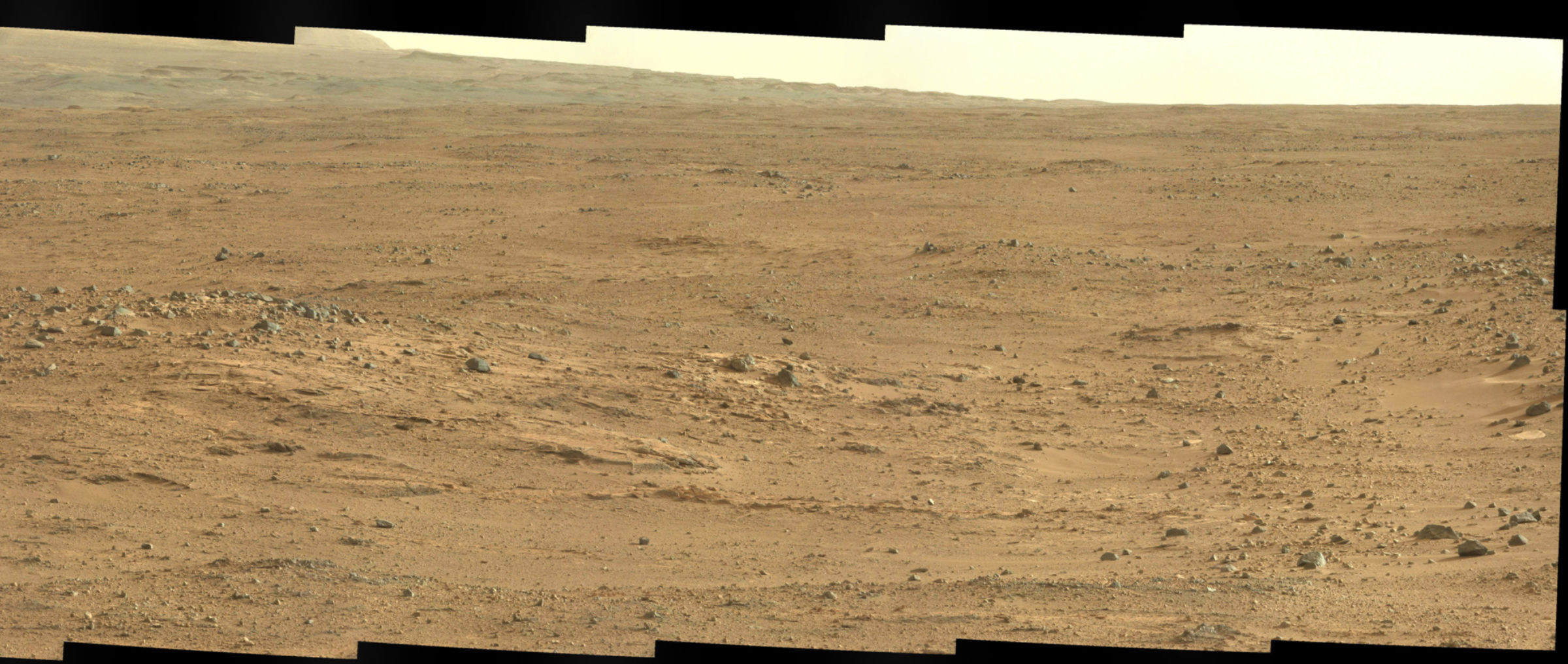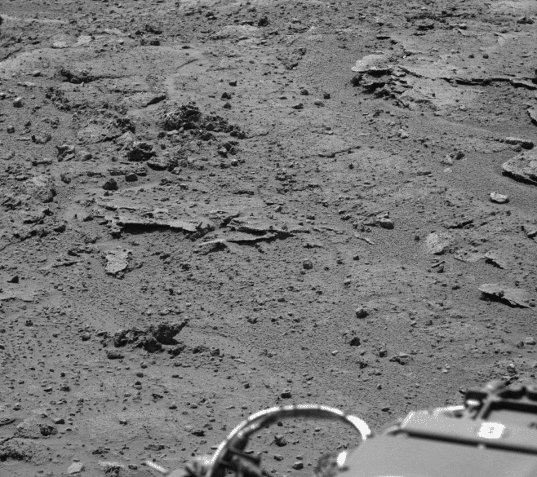Ken Herkenhoff • Oct 23, 2013
Curiosity update: Roving through the shutdown toward Waypoint 2, sols 388-432
Editor's note: At the end of September I had been debating whether to post the next round of Ken Herkenhoff's blog posts yet when the U.S. government shut down, taking with it the United States Geologic Survey (USGS) website on which they were posted. So this post rounds up a longer-than-usual set of Ken's posts. As he explains below, as a USGS employee, Ken was at risk of being furloughed himself, but because of his essential role in running the tactical operations of the Curiosity mission, he was exempted from furlough and allowed to continue working. He just couldn't write about operations while he was doing it until the rest of the government returned to work.
This blog is reposted with permission from the United States Geological Survey Astrogeology Science Center website. Images have been added by me. My favorite place to browse these images is midnightplanets.com. My favorite place to follow the rover's driving progress is curiositylog.com. Read this blog for an introduction to Herkenhoff's blog posts. --ESL
Sol 388: New Record Drive (12 September 2013)
I'm back from a week's vacation, catching up on everything that MSL has been doing. A new record for drive distance was set last week, 141 meters! Driving this far required lots of autonomous navigation, which left little time for science observations. Last weekend's plan included contact science (MAHLI and APXS) on rock outcrops and another drive toward "Waypoint 1," a location where more detailed studies are planned. If all goes well, the rover will be in position for contact science on the target "Darwin" tomorrow.
Sol 392-396: Waypoint 1 (13 September 2013)
The rover is in position to deploy the arm instruments on outcrops at Waypoint 1, so the weekend plan includes lots of APXS and MAHLI observations. So many contact and remote sensing observations were suggested that we didn't have time to include them all in the plan! A short drive, or "bump" to another interesting outcrop is planned for Sol 396, the last of the 3-sol plan. So it was a very hectic planning day but we were all happy with the result. The rover will be busy this weekend!

Sol 397: Blind Observations (17 September 2013)
MSL planning is restricted again this week, so Sol 397 was planned without knowing the position of the rover after the Sol 396 drive. Fortunately, there were a number of blind observations that could be scheduled this sol, including repeated Mastcam and Navcam observations of the ground left and right of the rover to measure the changes in reflectance at various times of day. This type of photometric campaign has helped us understand the properties and structure of the surface of Mars on previous missions, and we hope that new data will continue to inform us. In addition, ChemCam and Mastcam nighttime images of the Andromeda galaxy and the star Sirius were planned to test MSL's ability to observe the comets that are approaching the inner solar system.

Sol 398: The Veins (18 September 2013)
The short drive to the next contact science location at Waypoint 1 was successful, so we planned a lot of MAHLI images and a couple ChemCam observations of the veins in front of the rover. Planning is still restricted, so these data will not be received in time to plan Sol 399, but will be used to plan APXS observations of the veins on Sol 400.
Sol 399: Long Shift (19 September 2013)
Today is my last shift as SOWG Chair this week. The rover is in a stable position, so we were able to plan lots of contact science for Sol 399, including MAHLI and APXS observations of 5 different targets at Waypoint 1. It's a very complex plan, but we were able to add ChemCam and Mastcam observations of a couple targets before all the arm work. Because the plan is so complex, it was a long shift for the tactical team, lasting until 7 PM!

Sol 404: Back on the Road (24 September 2013)
The campaign at Waypoint 1 is complete, and MSL is back on the road toward Aeolis Mons ("Mt. Sharp"). Lots of observations were made at Waypoint 1, and are being analyzed as the data are returned to Earth. I'm MAHLI/MARDI uplink lead again today, planning the usual end-of-drive MAHLI and MARDI images. It's a much less hectic planning day than last week, as many of the observations taken on drive sols have become standardized. The emphasis continues to be on maximizing drive distance, so there isn't much time available for science observations.
Sol 405: Tight Spot (25 September 2013)
The autonomous navigation software could not find a safe path toward the rover's goal on Sol 404, so ended up in a configuration that prevented uplink of the Sol 405 command sequences directly to the high-gain antenna from Earth. Without new instructions, the rover executed the runout sequences that are loaded with every set of commands, just in case the new sequences are not received. This was only the sixth execution of autonav during a drive, so the software parameters were set conservatively, preventing the rover from trying to back up and drive around the rocks that it considered hazardous. As more experience is gained in driving with autonav, the rover will be allowed to get itself out of such tight spots. For now, the rover is safe and the Sol 406 plan includes another drive with autonav.
Update On Curiosity From USGS Scientist Ken Herkenhoff: Team Meeting (30 September 2013)
I'm in Pasadena this week for an MSL team meeting, but may have to return home tomorrow if the government is shut down. I'd hate to miss the meeting and associated discussions with my colleagues, but as a USGS civil servant I will be required to stop working and cut my trip short. Therefore, I might not be able to work on MSL until Congress reaches an agreement on the fiscal 2014 budget. Fortunately, the rover will continue to operate, as JPL employees are not civil servants. So, hopefully, the progress toward Mt. Sharp will continue.

Update On Curiosity From USGS Scientist Ken Herkenhoff: Active During Shutdown (17 October 2013)
I apologize for the gap in these updates— the USGS web servers were turned off during the government shutdown. Thanks to support from the MSL Project Scientist and my supervisor, I was permitted to support MSL tactical operations during the shutdown. Unfortunately, I was not allowed to attend the MSL science team meeting Oct. 1-3, but at least I could keep up with rover operations. I was MAHLI/MARDI PUL on October 8th and 10th, and SOWG Chair Oct. 14-15. The priority continues to be on driving, and we are a few drive sols away from the next waypoint. The team has agreed to make the stop for contact science at the next waypoint very brief, minimizing the delay in progress toward Aeolis Mons (Mt. Sharp), the ultimate goal of the mission. As winter approaches in Gale Crater, the lower temperatures mean that more heating, and therefore power, is needed for rover activities. This in turn constrains the time available for scientific observations and driving, so recent plans generally contain fewer activities that they did a few weeks ago. Still, it's good to be back at work full time, helping MSL and other missions achieve their goals.
Sol 428-430: Autumn on Mars (18 October 2013)
I forgot to mention previously that, unlike at other NASA Centers, JPL employees work for Caltech, not NASA directly. So they were not as immediately affected by the government shutdown as NASA and USGS employees. Therefore, because many of the people responsible for operating the rovers are at JPL, tactical operations could continue during the shutdown. So progress has been good, and the plan for this weekend includes another SAM measurement and a drive, among other observations. Again, the activities planned for this weekend are primarily constrained by power, but MSL can still do a lot as temperatures drop during the Martian (southern) autumn.

Sol 432: Untargeted Remote Sensing (22 October 2013)
MSL planning is still restricted, so we won't get confirmation of the drive planned for Sol 431 in time for planning Sol 432, which is therefore an untargeted-remote-sensing sol. The 432 plan also includes an overnight test of CheMin's ability to analyze sample while communicating with the MRO and Odyssey orbiters. I'm MAHLI/MARDI uplink lead today, with no activities to plan because the normal end-of-drive MAHLI and MARDI observations were included in the Sol 431 plan. But it's fun to be involved in tactical planning anyway, and I'll be helping to plan Sol 433 observations before I take off on vacation for the rest of this week.
Because the terrain the rover has been traversing is a bit rougher, progress has been somewhat slower during the past few sols. We will probably arrive at the second waypoint along the long traverse to Mt. Sharp next week, even if the pace continues to be slower than normal.
Support our core enterprises
Your support powers our mission to explore worlds, find life, and defend Earth. You make all the difference when you make a gift. Give today!
Donate

 Explore Worlds
Explore Worlds Find Life
Find Life Defend Earth
Defend Earth


